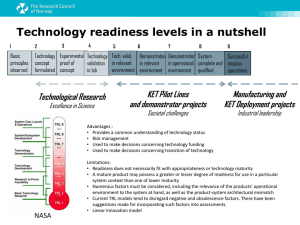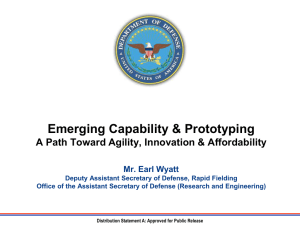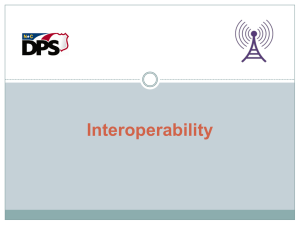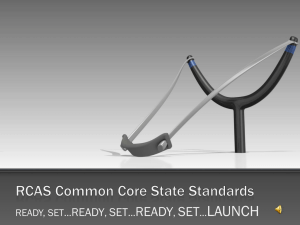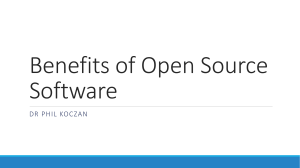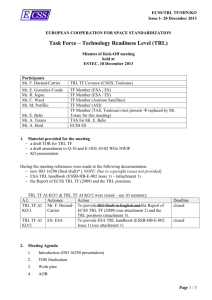August 2011 Lunch Brief - National Defense Industrial Association
advertisement
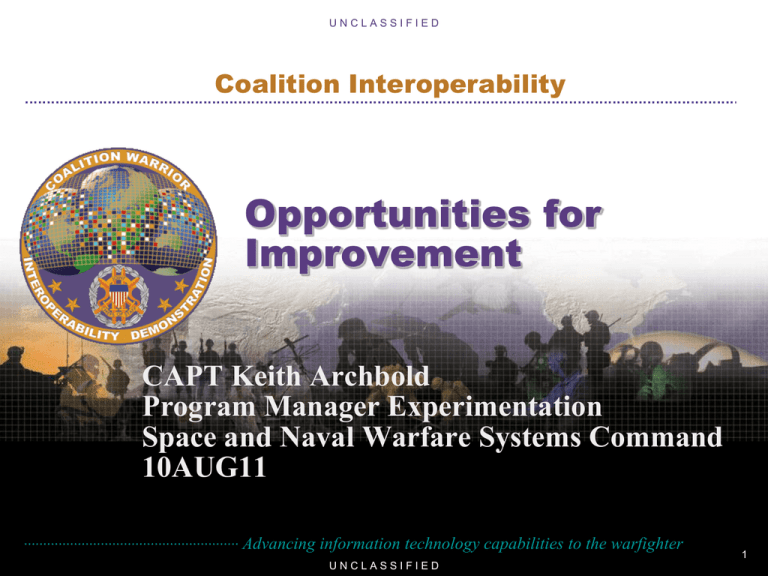
UNCLASSIFIED Coalition Interoperability Opportunities for Improvement CAPT Keith Archbold Program Manager Experimentation Space and Naval Warfare Systems Command 10AUG11 Advancing information technology capabilities to the warfighter UNCLASSIFIED 1 Quiz #1- GRE Refresher • How is the inverse of the discharge rate for a NiCad battery, related to “measureable” operational gains resulting from improved interoperability? Charge State Charge State 0r 0r Capability Capability t NiCad t Lead Acid Coalition Interoperability • Problem: Interoperability shortcomings result in mission failure and loss of life • Interoperability needs to be linked w/ Agile Development or “Extreme Programming”, and accomplished on the order of weeks, not months and years – “Google puts out a new version of G-mail to over 1.6 Billion users every two weeks” (counter threats and CIP) – Many structured experimentation/test/interoperability venues fail to deliver the volume or quality of results to shrink the gap – The POM Cycle doesn’t solve current interoperability problems- but that is generally our target US and Coalition Participation DHS Battle Lab, Herndon, VA CFBL Net ESC, Hanscom AFB CRC, Shirley’s Bay, Ottawa, Canada USJFCOM JSIC, Suffolk, VA NATO Bydgoszcz, Poland USNORTHCOM, Peterson AFB JFHQ, New Zealand ** SPAWAR, San Diego CTSF, Ft. Hood, TX ** Observer 4/8/2015 8:36 PM DSTL, United Kingdom ** DSTO Fern Hill, Australia ** 4 HS/HD Vignettes Arctic Sighting Vessel of Interest Fishing Vessel Spill Flooding Canadian Communication Blackout Influenza Outbreak Tunnel Explosion - Wildfires - Truck Bomb - RDD Attack - Chemical Attack - Suspicious Ship - VOI Missing Ship - Nuclear Threat - USCG Boarding Daily Commander Updates Cyber Attacks Montreal Mass Transit Incident - Spill of National Significance - Search and Rescue Wildfires - RDD - Flooding - NCR Evacuation - Chemical Attack - Bridge Attack - Nuclear Plant Incident - NCR Power Outage - RDD Attack - Water Supply Threat Hurricane/ Tropical Storm POTUS Visits - VOI Missing Ship - Missile Attack U N C L A S S I F I E D // F O R O F F I C I A L U S E O N L Y Environmental Realities: Capability Providers Feedback “My technology is just a component in a System of Systems, that is part of a larger System of Systems- I may have to rethink by business model” “Made some great connections, but don’t expect any hard dollar benefits for at least a year due to the DOD contracting process- lagging indicator of success” “My technology can increase computing speed by 800X and reduce overall power usage and hardware investment by 50%, but it is a disruptive technology that is not easily integrated into the existing marketresellers are not interested in my product since it cuts into their margins” “Having a footprint in Afghanistan and a secure and proven capability required by the warfighter will translate into immediate additional systems sales” Advancing information technology capabilities to the warfighter UNCLASSIFIED 6 Coalition Interoperability Indicators for 10 AUG 2011 81 859 24 Coalition Interoperability Indicators for 10 AUG 2011 Answer: Bottom Line- if capability providers do not reconcile themselves with these numbers, they risk becoming irrelevant. 81 Number of months takes the Pentagon to make a new computer system operational after it is first funded 859 Project budget cuts to DoD- original projected cuts were ~$453B 24 Number of months it took to develop the iPhone We need to develop affordable systems – and keep them current Fast refresh and specialization yield more capable systems E.g., >10x more processing power and storage Current Limitations: William Lynn, Deputy SecDef: “It takes the Pentagon 81 months to make a new computer system operational after it is first funded.” By contrast, he noted, “the iPhone was developed in 24 months.” Need to be more nimble to keep up with technology evolution JIOWC brief We have sufficient innovation and technology, we lack the transition nimbleness Stovepipe systems – Change a requirement, need a new design • Exploit commercial development process (not just COTS technology) • Think and act like a smart phone developer… Development Time (months) for Representative Systems PRS-13 (GPS) PRS-9 (UGS) PSQ-20 (NVS) 11.n 2x2 11.n 3x3 11.n 1x1 46 48 96 18 25 15 2.5x 1.5x But in these intervals technology matures: 4.5x 5x 24x UNCLASSIFIED DISTRIBUTION A - Approved for Public Release, Distribution Unlimited 2x 9 Rapid Integration Test Evaluation Process Shared Asset Libraries & Repositories TODAY Tester • Siloed development environments • Expensive and time consuming start-up • Limited exposure, sharing, or re-use • Duplication of effort • Develop by STR model Developer Developer Shared Test & Development Tools/Services/Environments Certifier User RITE • Cross-program sharing: enterprise software repository and services • Early and continuous integration • Agile approach to development life cycle • Extensible platform to support delivery of partner capabilities Infrastructure is in place and operational 10 RITE - New IT Acquisition Cycle Alignment: Better, But Not There Yet IOT&E Nat’l Defense Authorization Act 2010 RITE Life Cycle (SSA) Independent Iterative review & Test retrospective Iterative Design & Procure Selected Work Items/ Drops (~30 days) Daily Working System Approve Maintain Work Iterative Process to achieve Continuous Integration 11 Why Don’t We Just Use Android Based Smart Phones for Warfighting Applications? • Which is harder? Integration Readiness Level *Governance Readiness Level Technology Readiness Level * This is tough and often overlooked! RITE Software Maturation Model New or Migrating software Materiel Development Decision ICD Drop 1 Milestone A Drop 2 Drop 3 Drop Capability Cut-off 4 Milestone Build Decision TRL 1 TRL 2 TRL 3 TRL 4 TRL 5 TRL 6 TRL 7 TRL 8 Basic Principles Observed and Reported Technology application formulated Analytical Proof of Concept Component Validation in Lab Environment Component Validation in Relevant Environment Component Prototype Demonstrated in Relevant Environment System Prototype Demonstrated in Operational Environment System Completed through Test and Demo TRL 1 TRL 2 TRL 3 TRL 4 TRL 5 TRL 6 TRL 7 TRL 8 CDD (Milestone B) TRL 9 Candidate CRR Software Applications Target Readiness Gap POR Production Ready Candidate Software Gap Convergence Transition POR PRL 1 PRL 2 PRL 3 PRL 4 PRL 5 PRL 6 PRL 7 PRL 8 PRL 9 Production Readiness Levels (PRL) 13 The General Context • Business & Military Operations Involve – – – – • Many diverse stakeholders with differing cultures and responsibilities High degree of heterogeneity and redundancy in organizations, processes, and systems Large number of autonomous or stove-piped systems Inconsistent data/information models and data bases Business & Military Operations Need – – – – Cross-domain interoperation Ability to respond to unexpected events in timely and effective manner Decision support systems closely related to mission objectives Affordable “IT renovations” that provide improved and new capabilities in the short-term © HW Sorenson Some Observations and Assertions • We often fail, not because we fail to solve the problem we face, but because we fail to face the right problem. • There are three common ways to define the wrong problem and its resulting solution – As a deviation from the “norm” – As a result of inadequate resources – Or in terms of an existing solution • Interoperability requires the return to basics • Separate problem from solution – Context is important – Context-free solutions can lead to repeating successes but, also, the failures of the past – Avoid the endless search for more detail while drowning in the proliferation of useless information (iterate) © HW Sorenson Critical Components: Roadmap • Define the “outcome spaces” – What are desired “capabilities” (NOT specific requirements)? – Capabilities need to be defined carefully BUT should not be a “point solution” as produced by a requirements-driven process • Develop a “continuous interaction space” – Identify all stakeholders who are to be involved in the development of a specific capability • Include all legacy and new systems which contribute to the capability • Stakeholders define measures that enable “judgments” to be made about the utility of a solution approach • Choose utile solutions and discontinue less than satisfactory solutions • There must be “sensitivity” to possibly destructive behaviors introduced by “unsuccessful varieties” *Special thanks to UCSD Architecture Based Enterprise Systems Engineering Master’s Program and Professor Harold W. Sorenson for this slide and others in this presentation. © HW Sorenson Avoid destructive emergent behaviors, but embrace emergence Quiz #2: Sensitivity to destructive behaviors? What can be learned? © HW Sorenson I'm sure this guy still wonders why he got fired that day Emergence Among Disparate Technologies and Organizations: Ad Hoc Alliance Created a Full Motion Video Downlink capability in a Satellite and Comm’s Denied Environment CWID 2010 (unrehearsed “free play” portion) SOF Coast: Small Business founded by former Navy Seal Specializing in Low cost, portable, Aerostats US Army San Diego Harbor Police Emergency Operations Vehicle and Navy Region Southwest 18 Why Does It Take So Long Today? • Development is driven by fundamental tension between needs of the enterprise and of the local user – Internet, W3C, and IT enable solution for different “virtualization” views (i.e., structure) • • • • Trust virtualization and information governance Storage virtualization (SANs) Data virtualization (metadata repositories) Information virtualization (semantic grid) • “Data”, “information”, and “knowledge” are the medium of exchange* (i.e., function) © HW Sorenson Tight (old) versus Loose (new) Coupling (Reference: Kaye) Tight Coupling Loose Coupling Interaction Synchronous Asynchronous Messaging Style RPC Document Message Paths Hard Coded Routed Technology Mix Homogeneous Heterogeneous Data Types Dependent Independent Syntactic Definition By Convention Published Schema Bindings Fixed and Early Delayed Semantic Adaptation Software Objective By Re-coding Via Transformation Efficiency Broad Applicability Consequences Anticipated Unexpected © HW Sorenson Create effective interfaces for legacy systems Quiz #3 Effective Interfaces between COI’s? “Gee, guys... that seems like an awful lot of protective gear for such a small chlorine gas leak..." © HW Sorenson Making the Enterprise Interoperate Making the Enterprise Interoperate Use Cases 1 Operational/Mission Focused Community of Interest 1 ip ip ip ipip ip . . . Community of Interest n ip ip Domain k ipip Community of Interest 3 Domain 3 Domain 2 Domain 1 ip ipip Community of Interest 2 ip Use Cases 2 Use Cases 3 Use Cases m ... ip -Interoperability Point / stakeholders Organization/Systems Focused © HW Sorenson If you isolate the end user, the S/N ratio of your COI and Use cases is almost inaudible U.S. CWID 2011 Objectives: COI’s, Use Cases, Domains? Objective 1: Enhance Coalition, Joint and Service Integration and Interoperability in order to facilitate C4ISR transport /distribution and improve air/missile defense Objective 2: Enhance Whole of Government Integration and Interoperability in order to improve cyber-operations and support sustainable, secure mission partner collaboration Objective 3: Enhance Coalition Tactical Edge command and control; communications systems; and Intelligence, Surveillance, and Reconnaissance Capabilities in order to provide secure, deployable, modular, wireless communications in support of distributed small unit operations Objective 4: Improve Cross Domain Capabilities for both Conventional and Irregular Warfare Operations in order to provide multi-level web services, identification and authentication capabilities, and bi-directional Common Intelligence Picture/Common Operational Picture/Common Tactical Picture correlation/reporting capabilities within a federated multinational information sharing environment FBO Announcement and CWID Website @ www.cwid.js.mil Advancing information technology capabilities to the warfighter UNCLASSIFIED 23 CIAV Working Group: COI’s, Use Cases, Domains? Better! Purpose: The Coalition Interoperability Assurance & Validation Working Group (CIAV WG) is responsible for assuring and validating services, systems and business processes supporting the Afghanistan Mission Network (AMN) mission threads in support of Coalition Operations The CIAV WG coordinates AV events per IJC/National direction and provides results/recommendations on mission and service interoperability improvement across AMN Advancing information technology capabilities to the warfighter UNCLASSIFIED 24 Don’t be restricted by the practices of the past Quiz #4 Good or Bad Practice? And to think... those wimps at the power company use straps and cleats to get up this high!" © HW Sorenson Make small changes quickly CWIX Vs. CWID Quiz #5 Good or Bad? Practice or Implementation? "Jack stands? Hah! Who needs 'em?" © HW Sorenson Be innovative and adaptive Quiz #6 Effective Strategy? Necessity is the mother of invention.. © HW Sorenson Involve stakeholders in assessing the outcome space Quiz #7 Requirementsbased vs. outcome space Step 1: Remove shoes. Step 2: Place metal ladder in water. Step 3: Begin using power tools while standing barefoot on metal ladder in water. © HW Sorenson InReleif.org: Roadmap for Success • HADR Capability Born out of CWID 2008 • In use today in Haiti and Japan disasters • Tops down, bottoms up approach- “worked” at both OSD and Experimentation/Demo Levels • Open Source/Existing off-the-shelf technology • Clear Total Cost of Ownership Advantage • Its all about making the Enterprise Interoperate • Concept of Emergence- Google, VSEE, SPOT • Understand Architectures, Use Cases, and COI’s at Multiple levels of Interaction Conclusion: DARPA Best of Breed Approach • ADAPT promotes a new way of doing business – Ecosystems – Non-traditional military contractors working with traditional performers – Reuse and refresh mentality – Leverage everything possible – Getting product in the field takes precedence Accelerate development time UNCLASSIFIED DISTRIBUTION A - Approved for Public Release, Distribution Unlimited 30 Quiz #1 • How is the inverse of the discharge rate for a NiCad battery, related to “measureable” operational gains resulting from improved interoperability? Charge State Charge State 0r 0r Capability Capability t NiCad t Lead Acid Answer Q: Why is it that I can watch an NFL game on my iPhone anywhere in the world live; but the typical Destroyer has communications bandwidth that is on par with a library in Ethiopia? By the time we get here (3), it is a context free solution- or worse yet a “wrong” solution- or worse yet irrelevant. A= capability needed 2 Finish 3 Required Charge State or Capability Capability Gap 1 Start Future t now Bottom Line: If we don’t anticipate and adjust to 81 & 859, we will cease to be relevant- it is up to you. There are a lot of smart companies out there, will you be the next Google in this space? ADAPT (DARPA): A new business approach for military development 1. Rapid refresh and obsolescence Get products in the field, let technology catch up • Leverage commercial technology when prudent 2. Leverage reusable system core hardware and software • • Processing/communication/navigation • New approach to interoperable systems • Stop repeated development Cost/ Schedule Performance Performance Flexible interface for unique sensors Sensors change but management core is common to all Today’s Military Sensor Core vs. Smart Phone Core Fabless product development model 3. Implement a reusable SW distribution model. • Commercial-style development ecosystem • A “head start” to development 4. Enable “technology participants” – App developers and sensor physics providers • Schedule/ Cost Reuse the common parts of a system • • Commercial Development Drives • Military Development Drives • A path for technology integration from 3rd parties Military Commercial 6 PCB 1 PCB 2 radios, 5Mbps max 3 radios, >100Mbps 30MIps + 8MB 16 bit processor 1000MIps + 16GB 64 bit processor >$3500 <$500 UNCLASSIFIED DISTRIBUTION A - Approved for Public Release, Distribution Unlimited 33
